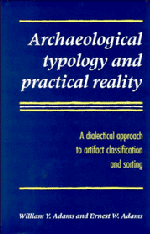 Archaeological Typology and Practical Reality
Archaeological Typology and Practical Reality Book contents
- Frontmatter
- Contents
- List of figures
- List of tables
- The archaeologist's preface
- The philosopher's preface
- PART I Introductory
- 1 Beginning points
- 2 Introductory theses
- PART II The nature of types and typologies
- PART III Typology in action: the Medieval Nubian Pottery Typology
- PART IV Pragmatics of archaeological typology
- PART V Classification, explanation, and theory
- Appendices
- References
- Index
2 - Introductory theses
Published online by Cambridge University Press: 23 November 2009
- Frontmatter
- Contents
- List of figures
- List of tables
- The archaeologist's preface
- The philosopher's preface
- PART I Introductory
- 1 Beginning points
- 2 Introductory theses
- PART II The nature of types and typologies
- PART III Typology in action: the Medieval Nubian Pottery Typology
- PART IV Pragmatics of archaeological typology
- PART V Classification, explanation, and theory
- Appendices
- References
- Index
Summary
This chapter will state briefly the major theses that are to be elaborated in later chapters. It will serve at the same time as an introductory guide to the remaining parts of the book, so that readers with particular interests may judge for themselves which chapters are and are not germane to them. Since there is no point in describing what has presumably already been read, we will begin our review with Part II. In the paragraphs that follow, the numbers that precede each heading are chapter numbers.
Part II The nature of types and typologies
Part II is occupied with preliminary considerations about the nature of human concept formation, the organization of concepts into languages, classifications, and typologies, the special structural features of typologies, and the nature of types and type concepts individually.
3 Dimensions and elements of “typehood.” We have at the outset to establish at least a working definition of what we mean by the word “type,” although we are not yet ready to offer a formal definition. Accordingly we begin Chapter 3 by considering the different usages of the word in scientific literature, observing that it refers sometimes to a group of physical entities, sometimes to our ideas about a group of entities, and sometimes to the words and/or pictures in which we express those ideas.
- Type
- Chapter
- Information
- Archaeological Typology and Practical RealityA Dialectical Approach to Artifact Classification and Sorting, pp. 18 - 26Publisher: Cambridge University PressPrint publication year: 1991
